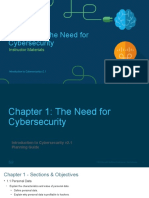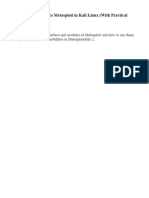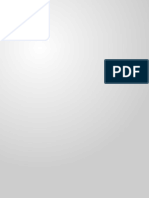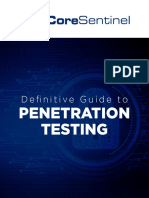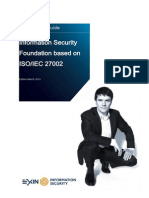Module 4
Uploaded by
Paula Bianca DomingoModule 4
Uploaded by
Paula Bianca DomingoILOCOS SUR
POLYTECHNIC STATE
Candon Campus
COLLEGE
MODULE II
INTENDED LEARNING ACTIVITY – MODULE 4
NAME: Edralin B. Dalgo Jr. DATE:
COURSE AND YEAR: BSHM 1-D SCORE: ________
Direction: Look at the following images and create a hashtag based on the type of online
threat represented by each image (10 points).
1. #ICanSeeYou 2. #ClickBait
3. #AntiVirus 4. #NowhereToHide
5. #GiveMeYourMoney
Course Code: GEN ED ELECT 101
Descriptive Title: LIVING IN THE IT ERA
Instructor: CLARIZA G. VALDEZ, MIT
ILOCOS SUR
POLYTECHNIC STATE
Candon Campus
COLLEGE
MODULE II
ASSESSMENT – MODULE 4
NAME: Edralin B. Dalgo Jr. DATE:
COURSE AND YEAR: BSHM 1-D SCORE: ________
IDENTIFICATION: Read the questions carefully. Write your answer before the
number.
Malicious Software 1. Malware is a short term used for .
Lock screen Ransomware 2. It displays an image that prevents you from
accessing your computer.
Pharming 3. is a common type of online fraud.
Internet Etiquette. 4. Netiquette is a short term used for .
Spam. 5.The mass distribution of unsolicited messages, advertising or
pornography to addresses which can be easily found on the internet.
Spyware and Adware 6. and are often used by third parties
to infiltrate your computer.
Trojan Horses 7. It is an executable file that will install itself and run
automatically once it’s downloaded.
Viruses 8. Malicious computer programs that are often sent as an email
attachment or a download with the intent of infecting your computer.
Spam 9. It is one of the more common methods of both sending information
out and collecting it from unsuspecting people.
Netiquette 10. It is a set of rules for behaving properly online.
Ransomware 11. A type of malware that restricts access to your computer or
your files and displays a message that demands payment for the restriction to
be removed.
Pharming 12. A means to point you to a malicious and illegitimate
website by redirecting the legitimate URL.
Worms 13. are common threat to computer and the internet as a
whole.
Course Code: GEN ED ELECT 101
Descriptive Title: LIVING IN THE IT ERA
Instructor: CLARIZA G. VALDEZ, MIT
ILOCOS SUR
POLYTECHNIC STATE
Candon Campus
COLLEGE
MODULE II
Hacking 14. Action taken by someone to gain unauthorized access to a
computer.
Encryption Ransomware 15. It encrypts files on your system’s hard drive
and sometimes on shared network, drives, USB drives, and external hard
drives and even some cloud storage drives preventing you from opening them.
Spyware and Adware 16. They often come in the form of a free download
and are installed automatically with or without your consent.
Trojan Horses 17. A malicious program that is disguised as or embedded
within legitimate software.
Wi-Fi Eavesdropping 18. Virtual listening in on your information that’s
shared over an unsecured or not encrypted network.
Netiquette 19. It is the proper way to communicate in an online environment.
Spyware and Adware 20. Software that collects personal information about
you without you knowing it.
Course Code: GEN ED ELECT 101
Descriptive Title: LIVING IN THE IT ERA
Instructor: CLARIZA G. VALDEZ, MIT
You might also like
- Chapter 1: The Need For Cybersecurity: Instructor MaterialsNo ratings yetChapter 1: The Need For Cybersecurity: Instructor Materials23 pages
- Module 4: ASSESSMENT: Malicious SoftwareNo ratings yetModule 4: ASSESSMENT: Malicious Software1 page
- Assessment: IDENTIFICATION: Read The Questions Carefully. Write Your Answer Before The NumberNo ratings yetAssessment: IDENTIFICATION: Read The Questions Carefully. Write Your Answer Before The Number3 pages
- Module 4 - Computer and Network SecurityNo ratings yetModule 4 - Computer and Network Security30 pages
- Camille": Due Date: Midnight of July 26, 2014No ratings yetCamille": Due Date: Midnight of July 26, 20143 pages
- 3. ITE101 WEEK 5 TOPIC the Netiquette and the Computer Ethics.No ratings yet3. ITE101 WEEK 5 TOPIC the Netiquette and the Computer Ethics.29 pages
- Online Safety, Security Safety and Etiquette PPT Lovely FNo ratings yetOnline Safety, Security Safety and Etiquette PPT Lovely F39 pages
- Online Safety Security Ethics EtiquetteNo ratings yetOnline Safety Security Ethics Etiquette50 pages
- Lesson 2 Online Safety Security Ethics andNo ratings yetLesson 2 Online Safety Security Ethics and56 pages
- Online Safety, Security, Ethics and Netiquette100% (1)Online Safety, Security, Ethics and Netiquette42 pages
- Empowerment Technology Lesson 2 Reviewer MaterialNo ratings yetEmpowerment Technology Lesson 2 Reviewer Material5 pages
- W2 Online Safety Security Ethics and Etiquette StudentsNo ratings yetW2 Online Safety Security Ethics and Etiquette Students17 pages
- Cyber Security Awareness Month Word SearchNo ratings yetCyber Security Awareness Month Word Search2 pages
- 1 Introduction To Bar and Beverage Management75% (4)1 Introduction To Bar and Beverage Management34 pages
- Ge Elect 103 Environmental Science: Amabel Marina C. Marcaida, Mase Assistant Professor 3No ratings yetGe Elect 103 Environmental Science: Amabel Marina C. Marcaida, Mase Assistant Professor 322 pages
- Intrusion Detection System IDS Seminar ReportNo ratings yetIntrusion Detection System IDS Seminar Report18 pages
- Subject Code-3507: Roll No. ....................... Exam Code: S-20No ratings yetSubject Code-3507: Roll No. ....................... Exam Code: S-202 pages
- Blockchain November 05, 2022 Lecture NotesNo ratings yetBlockchain November 05, 2022 Lecture Notes4 pages
- Answer CCNA Security Chapter 7 Test - CCNAS v1.1 - Invisible AlgorithmNo ratings yetAnswer CCNA Security Chapter 7 Test - CCNAS v1.1 - Invisible Algorithm10 pages
- ENISA Report - Post-Quantum Cryptography Current State and Quantum Mitigation-V2No ratings yetENISA Report - Post-Quantum Cryptography Current State and Quantum Mitigation-V246 pages
- FULL PPT - A Privacy Preserving Medical Records Storage in Cloud Environment Using Deep EncryptionNo ratings yetFULL PPT - A Privacy Preserving Medical Records Storage in Cloud Environment Using Deep Encryption27 pages
- English Preparation Guide Exin Isfs 201403 PDFNo ratings yetEnglish Preparation Guide Exin Isfs 201403 PDF16 pages
- Cryptographer's Way - Bradford Hardie IIINo ratings yetCryptographer's Way - Bradford Hardie III100 pages
- Acunetix Web Application Vulnerability Report 2019 PDFNo ratings yetAcunetix Web Application Vulnerability Report 2019 PDF27 pages
- CTHSEC-1001-The Future of Transport Layer SecurityNo ratings yetCTHSEC-1001-The Future of Transport Layer Security28 pages
- Online Safety Security Ethics and NetiquettesNo ratings yetOnline Safety Security Ethics and Netiquettes17 pages
